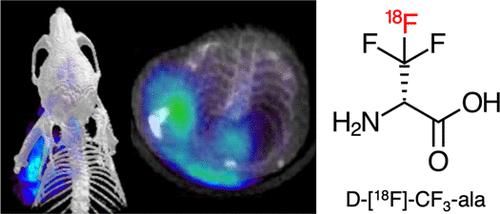Our official English website, www.x-mol.net, welcomes your
feedback! (Note: you will need to create a separate account there.)
Peptidoglycan-Targeted [18F]3,3,3-Trifluoro-d-alanine Tracer for Imaging Bacterial Infection
JACS Au ( IF 8.5 ) Pub Date : 2024-02-25 , DOI: 10.1021/jacsau.3c00776
Alexandre M Sorlin 1 , Marina López-Álvarez 1 , Jacob Biboy 2 , Joe Gray 2 , Sarah J Rabbitt 1 , Junaid Ur Rahim 1 , Sang Hee Lee 1 , Kondapa Naidu Bobba 1 , Joseph Blecha 1 , Mathew F L Parker 1, 3 , Robert R Flavell 1, 4, 5 , Joanne Engel 6, 7 , Michael Ohliger 1, 8 , Waldemar Vollmer 2, 9 , David M Wilson 1
JACS Au ( IF 8.5 ) Pub Date : 2024-02-25 , DOI: 10.1021/jacsau.3c00776
Alexandre M Sorlin 1 , Marina López-Álvarez 1 , Jacob Biboy 2 , Joe Gray 2 , Sarah J Rabbitt 1 , Junaid Ur Rahim 1 , Sang Hee Lee 1 , Kondapa Naidu Bobba 1 , Joseph Blecha 1 , Mathew F L Parker 1, 3 , Robert R Flavell 1, 4, 5 , Joanne Engel 6, 7 , Michael Ohliger 1, 8 , Waldemar Vollmer 2, 9 , David M Wilson 1
Affiliation

|
Imaging is increasingly used to detect and monitor bacterial infection. Both anatomic (X-rays, computed tomography, ultrasound, and MRI) and nuclear medicine ([111In]-WBC SPECT, [18F]FDG PET) techniques are used in clinical practice but lack specificity for the causative microorganisms themselves. To meet this challenge, many groups have developed imaging methods that target pathogen-specific metabolism, including PET tracers integrated into the bacterial cell wall. We have previously reported the d-amino acid derived PET radiotracers d-methyl-[11C]-methionine, d-[3-11C]-alanine, and d-[3-11C]-alanine-d-alanine, which showed robust bacterial accumulation in vitro and in vivo. Given the clinical importance of radionuclide half-life, in the current study, we developed [18F]3,3,3-trifluoro-d-alanine (d-[18F]-CF3-ala), a fluorine-18 labeled tracer. We tested the hypothesis that d-[18F]-CF3-ala would be incorporated into bacterial peptidoglycan given its structural similarity to d-alanine itself. NMR analysis showed that the fluorine-19 parent amino acid d-[19F]-CF3-ala was stable in human and mouse serum. d-[19F]-CF3-ala was also a poor substrate for d-amino acid oxidase, the enzyme largely responsible for mammalian d-amino acid metabolism and a likely contributor to background signals using d-amino acid derived PET tracers. In addition, d-[19F]-CF3-ala showed robust incorporation into Escherichia coli peptidoglycan, as detected by HPLC/mass spectrometry. Based on these promising results, we developed a radiosynthesis of d-[18F]-CF3-ala via displacement of a bromo-precursor with [18F]fluoride followed by chiral stationary phase HPLC. Unexpectedly, the accumulation of d-[18F]-CF3-ala by bacteria in vitro was highest for Gram-negative pathogens in particular E. coli. In a murine model of acute bacterial infection, d-[18F]-CF3-ala could distinguish live from heat-killed E. coli, with low background signals. These results indicate the viability of [18F]-modified d-amino acids for infection imaging and indicate that improved specificity for bacterial metabolism can improve tracer performance.
中文翻译:

用于细菌感染成像的肽聚糖靶向 [18F]3,3,3-三氟-d-丙氨酸示踪剂
成像越来越多地用于检测和监测细菌感染。解剖学(X 射线、计算机断层扫描、超声和 MRI)和核医学([ 111 In]-WBC SPECT、[ 18 F]FDG PET)技术均用于临床实践,但缺乏对致病微生物本身的特异性。为了应对这一挑战,许多研究小组开发了针对病原体特异性代谢的成像方法,包括整合到细菌细胞壁中的 PET 示踪剂。我们之前报道过d-氨基酸衍生的PET放射性示踪剂d-甲基-[ 11 C]-蛋氨酸、 d- [3- 11 C]-丙氨酸和d- [3- 11 C]-丙氨酸-d-丙氨酸,这表明细菌在体外和体内积累强劲。鉴于放射性核素半衰期的临床重要性,在本研究中,我们开发了[ 18 F]3,3,3-三氟-d-丙氨酸( d -[ 18 F]-CF 3 -ala),一种氟 18标记的示踪剂。我们测试了以下假设:鉴于d -[ 18 F]-CF 3 -ala 与d -丙氨酸本身的结构相似,它将被纳入细菌肽聚糖中。 NMR分析表明,氟19母体氨基酸d- [ 19 F]-CF 3 -ala在人和小鼠血清中稳定。 d -[ 19 F]-CF 3 -ala 也是d - 氨基酸氧化酶的不良底物,该酶主要负责哺乳动物d - 氨基酸代谢,并且可能是使用d - 氨基酸衍生的 PET 示踪剂的背景信号的贡献者。此外,通过HPLC/质谱检测, d- [ 19 F]-CF 3 -ala 表现出与大肠杆菌肽聚糖的牢固结合。基于这些有希望的结果,我们通过用[ 18 F]氟化物置换溴前体,然后进行手性固定相HPLC,开发了d- [ 18 F]-CF 3 -ala的放射合成方法。出乎意料的是,体外细菌对d- [ 18 F]-CF 3 -ala的积累对于革兰氏阴性病原体,特别是大肠杆菌是最高的。在急性细菌感染的小鼠模型中, d -[ 18 F]-CF 3 -ala 可以以低背景信号区分活大肠杆菌和热灭活大肠杆菌。这些结果表明[ 18 F]-修饰的d-氨基酸用于感染成像的可行性,并表明改善细菌代谢的特异性可以改善示踪剂性能。
更新日期:2024-02-25
中文翻译:

用于细菌感染成像的肽聚糖靶向 [18F]3,3,3-三氟-d-丙氨酸示踪剂
成像越来越多地用于检测和监测细菌感染。解剖学(X 射线、计算机断层扫描、超声和 MRI)和核医学([ 111 In]-WBC SPECT、[ 18 F]FDG PET)技术均用于临床实践,但缺乏对致病微生物本身的特异性。为了应对这一挑战,许多研究小组开发了针对病原体特异性代谢的成像方法,包括整合到细菌细胞壁中的 PET 示踪剂。我们之前报道过d-氨基酸衍生的PET放射性示踪剂d-甲基-[ 11 C]-蛋氨酸、 d- [3- 11 C]-丙氨酸和d- [3- 11 C]-丙氨酸-d-丙氨酸,这表明细菌在体外和体内积累强劲。鉴于放射性核素半衰期的临床重要性,在本研究中,我们开发了[ 18 F]3,3,3-三氟-d-丙氨酸( d -[ 18 F]-CF 3 -ala),一种氟 18标记的示踪剂。我们测试了以下假设:鉴于d -[ 18 F]-CF 3 -ala 与d -丙氨酸本身的结构相似,它将被纳入细菌肽聚糖中。 NMR分析表明,氟19母体氨基酸d- [ 19 F]-CF 3 -ala在人和小鼠血清中稳定。 d -[ 19 F]-CF 3 -ala 也是d - 氨基酸氧化酶的不良底物,该酶主要负责哺乳动物d - 氨基酸代谢,并且可能是使用d - 氨基酸衍生的 PET 示踪剂的背景信号的贡献者。此外,通过HPLC/质谱检测, d- [ 19 F]-CF 3 -ala 表现出与大肠杆菌肽聚糖的牢固结合。基于这些有希望的结果,我们通过用[ 18 F]氟化物置换溴前体,然后进行手性固定相HPLC,开发了d- [ 18 F]-CF 3 -ala的放射合成方法。出乎意料的是,体外细菌对d- [ 18 F]-CF 3 -ala的积累对于革兰氏阴性病原体,特别是大肠杆菌是最高的。在急性细菌感染的小鼠模型中, d -[ 18 F]-CF 3 -ala 可以以低背景信号区分活大肠杆菌和热灭活大肠杆菌。这些结果表明[ 18 F]-修饰的d-氨基酸用于感染成像的可行性,并表明改善细菌代谢的特异性可以改善示踪剂性能。

































 京公网安备 11010802027423号
京公网安备 11010802027423号